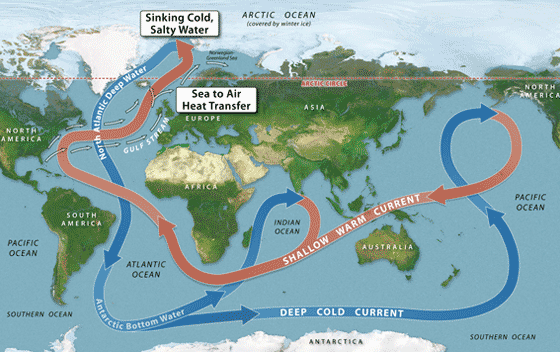The Global Conveyor Belt

a world map illustrating global ocean circulation patterns, highlighting the movement of warm and cold water currents. The map shows continents including North America, South America, Europe, Africa, Asia, Australia, and Antarctica, with the Arctic Ocean covered by ice at the top and the Southern Ocean at the bottom. Red arrows indicate warm currents: the Gulf Stream and North Atlantic Deep Water flow northward from the Atlantic Ocean, while the Indian Warm Current and Pacific Current circulate through their respective oceans. Blue arrows represent cold currents: the Deep Cold Current and Antarctic Bottom Water flow southward from the Arctic and around Antarctica. Labels also note "Sinking Cold, Salty Water" and "Sea to Air Heat Transfer" in the Arctic region.
- Continents
- North America: Northwest region
- South America: Southwest region
- Europe: Western region
- Africa: Central region
- Asia: Eastern region
- Australia: Southeast region
- Antarctica: Southern region
- Oceans
- Arctic Ocean: Top, covered by ice
- Pacific Ocean: Central-east
- Atlantic Ocean: Central-west
- Indian Ocean: Central-south
- Southern Ocean: Bottom
- Warm Currents (Red Arrows)
- Gulf Stream
- Path: Northward from the Atlantic Ocean near North America
- North Atlantic Deep Water
- Path: Northward continuation from the Gulf Stream
- Indian Warm Current
- Path: Circulates through the Indian Ocean
- Pacific Current
- Path: Loops through the Pacific Ocean
- Gulf Stream
- Cold Currents (Blue Arrows)
- Deep Cold Current
- Path: Southward from the Arctic Ocean
- Antarctic Bottom Water
- Path: Circulates around Antarctica
- Deep Cold Current
- Arctic Region Features
- Sinking Cold, Salty Water
- Position: Near the Arctic Ocean
- Sea to Air Heat Transfer
- Position: Near the Arctic Ocean
- Sinking Cold, Salty Water
- Additional Notes
- Arctic Circle: Marked near the top
- Color Coding: Red for warm currents, blue for cold currents
As we have seen, surface ocean currents are the dominant sources of deep water masses. In fact, it is a little more complicated than this, as other deep water masses also feed one another. However, in a generalized sense, the surface and deep ocean currents can be viewed as an integrated system known as the Global Conveyor Belt, a concept conceived by the brilliant Geoscientist Wally Broecker of Columbia University. Diagrams of the Global Conveyor Belt (GCB) are two-dimensional and therefore simplified and do not, for example, include all of the intermediate water masses or surface water currents. However, the key of the Global Conveyor Belt concept is that it explains the general systems of heat transport as well as bottom water aging and nutrient supply in the oceans.
Global Conveyor Belt
The following animation traces the path of water through the surface and deep ocean, showing the dominant features of the GCB, including formation of NADW in the North Atlantic.
Video: The Thermohaline Circulation - The Great Ocean Conveyer Belt (2:46) This video is not narrated.
The GCB shows the dominant source of deep water in the oceans as North Atlantic Deep Water, and how this splits in two to flow into the Indian and Pacific Oceans. In these locations, upwelling of the deep water mass produces surface water currents that generally flow back towards the original source of deep water in the North Atlantic. For heat supply, the conveyor belt involves the transport of heat and moisture to northwest Europe by the Gulf Stream; this accounts for about 30% of the heat budget for the Arctic region, making the GCB extremely important for climate in the Arctic.
Because deep-water masses circulate very slowly, the GCB takes about 1500 years to complete, meaning that the oldest water in the oceans is about this age. In addition, because oxygen is gradually depleted in deep waters as they age, and because CO2 contents and nutrients conversely increase, the oldest water masses of the ocean in the North Pacific are among the most nutrient-rich, CO2 rich, and oxygen-depleted waters in the ocean. Conversely, the newly produced NADW waters are among the most nutrient-depleted, CO2 depleted, and well-oxygenated waters in the world.
As it turns out, recent research on the detailed configuration of surface and deep currents shows that circulation is much more complex than the GCB. Floats deployed in the ocean don’t always follow expected pathways in the GCB model. Wind actually plays a more significant role in causing downwelling than previously thought. Moreover, mixing by small systems or eddies plays a large role in driving surface currents.
